Kristine Hughes's Blog, page 126
May 23, 2012
200 Years Ago: Spring and Summer Fashions
Here are a few fashions from 200 years ago, from Victoria's print collection. You might see something similar at Jane Austen Society meetings, Regency Dance groups, or Writer's conventions, but few us us would probably want to cope with these outfits every day. Or want to change gowns several times a day.
At the end is a greatcoat for a gentleman to wear in the cool weather.
Thanks to Sue Forgue at the Regency Encyclopedia for some of the descriptions I was missing.
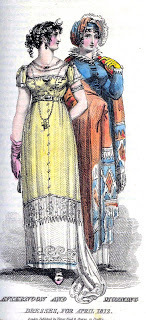 Ladies Monthly Museum, April 1812
Ladies Monthly Museum, April 1812
The Full Dress (left), for this month, is made of white satin, ornamented round the bottom with a rich Grecian border, over which is worn a tunic of yellow Italian gauze, trimmed with deep white lace, and fastened up the front with cord of blue silk. Head dress à la Diana, ornamented with wreathes of artificial flowers in dead gold, with a crescent in front of the forehead, composed of pearls and sapphire; the necklace and ear rings to correspond; kid gloves and shoes of pale pink.
The Walking Dress (right) is a white Indian robe of Muslin, made high in the neck; with a richly worked collar to turn over that of the pelisse, which is of blue silk, trimmed with white lace; over which is worn a white,or coloured shawl; the bonnet to be of the same materials as the shawl, and is ornamented with a white feather;--laced half boots of regency brown.
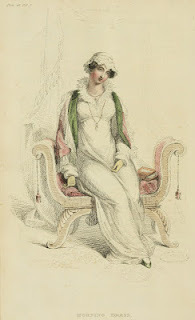 Ackermann's Repository Morning Dress April 1812
Ackermann's Repository Morning Dress April 1812
A superfine Scotch or French cambric, over a cambric slip, with full long sleeves, and ruff à la Mary Queen of Scots. A neck-chain and sight set in gold; bracelets and necklace of white or red cornelian. A Flora cap, composed of white satin and lace. A capuchin or French cloak of blossom satin or Pomona green, trimmed with thread lace. Slippers of pale pink or green kid; and gloves of tan or Limerick kid.
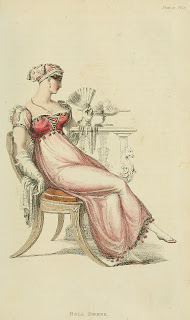 Ackermann's Repository, Ball Gown, April, 1812
Ackermann's Repository, Ball Gown, April, 1812
A round ciracassian robe of pink crape, or gossamer net, over a white satin slip, fringed full at the feet; a peasant's bodice, of pink satin or velvet, laced in front with silver, and decorated with the same ornament. Spanish slash sleeve, embellished with white crape foldings, and furnished at its terminations with bands of silver. A Spartan or Calypso helmet cap, of pink frosted crape, with silver bandeaus, and embellished with tassels, and rosets to correspond. A rich neck-chain and ear-rings of Oriental gold. Fan of carved ivory. Slippers of pink kid, with correspondent clasps; and gloves of white kid: an occasional square veil of Mechlin lace
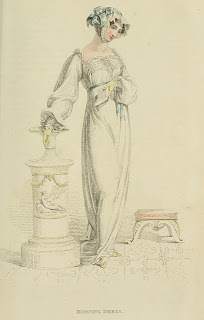 Ackermann's Repository, Morning Dress, May 1812
Ackermann's Repository, Morning Dress, May 1812
A French frock of fine plain India muslin, with demi-train, and long full bishop's sleeves. Waggoners' cuffs, with gaged front, and shoulders to correspond. Tucker of double-rolled muslin, which also finishes the cuffs round the hands. A Parisian mob cap of fine lace, confined round the head, and terminating on one side with a celestial blue or silver grey ribbon. Sash of the same, tied in small bows and ends in front. Hair in waved curls, divided in the center of the forehead. Spanish slippers of lemon-coloured kid, and gloves of the same material. The peculiar taste and elegant simplicity of these habiliments are further specimens of the graceful invention of the celebrated Mrs. Gill, of Cork-street, Burlington-gardens, from whom we have obtained them.
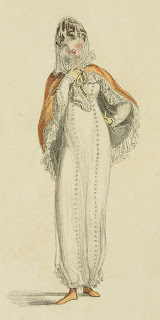 Ackermann's Repository, June 1812
Ackermann's Repository, June 1812
A round robe of jaconot or fine cambric muslin, with long sleeve and high waist, with fan ruff of lace, ornamented up the front with borders of needle-work or lace, and finished at the feet with ball fringe. A Spanish hussar clock of deep amber sarsnet, lined with sea green or white, and trimmed with broad thread lace, put on very full. Hair disposed in bands and waved curls; a large square veil of white lace, thrown over the head and shading the face. Half-boots amber-coloured kid, and gloves a pale primrose. Small French caps of lace, ornamented with a small cluster of spring flowers, on one side, are often seen in this style of costume, and have an appropriate and pretty effect beneath the long veil.
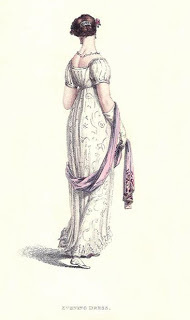 Ackermann's Repository, July 1812
Ackermann's Repository, July 1812
An embroidered crape round robe, decorated at the feet with a deep Vandyke fringe; short melon sleeve; bosom and back to correspond. White or blossom satin under dress. Hair a dishevelled crop, ornamented with a small cluster of the Chinese rose on each side, and confined with a comb of pearl at the back of the head. Necklace, ear-rings, and bracelets, of pearl and wrought gold. Grecian scarf of lilac silk, with embroidered variegated ends. Slippers of white satin, and gloves of French kid. Fan of imperial crape and ivory, embellished with gold antique devices.
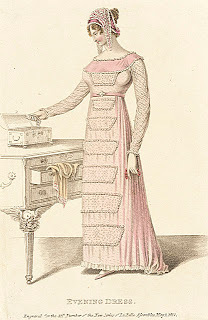 La Belle Assemblee, Evening Dress, April 1812
La Belle Assemblee, Evening Dress, April 1812
An embroidered white crape, or fine India muslin frock, with long sleeves, and trimmed round the bottom with fine lace, set on full, worn over a blush colour satin or sarsnet slip; the frock ornamented down the front of the skirt with beads and lace in the Egyptian style. Parisian mob, worn unfastened, of puckered pink, and white crape over pink satin. Small pink satin tippet, with full plaiting of lace. Cestus of pale pink, confined by a clasp of pearl. Pink satin slippers, with white rosettes. The jewellery worn with this dress is the shaded cornelian or large pearls.
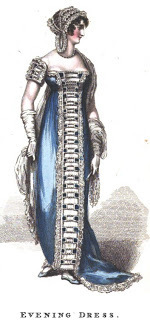 La Belle Assemblee, Evening Dress, 1812
La Belle Assemblee, Evening Dress, 1812
A robe of Imperial blue sarsnet, shot with white, with a demi train, ornamented with fine French lace down each side the front and round the bottom; the trimming surmounted by a white satin ribband; the robe left open a small space down the front, and fastened with clasps of sapphire and pearl over a white satin slip petticoat: short fancy sleeve to correspond with the ornaments of the robe. Parisian cap made open, formed of rows of fine lace and strings of pearl, the hair dressed à-la-Henriette of France, appearing between, and much separated on the forehead. Pearl necklace, and hoop earrings of the same. Scarf shawl in twisted drapery of fine white lace. White kid gloves and fan of ivory, ornamented with gold. Slippers the same colour as the robe, with white rosettes. This beautiful dress is the creation of Miss Walters, Wigmore-street, Cavendish-square
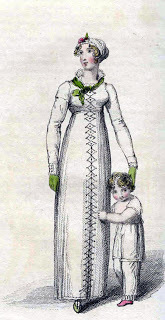 Ladies Monthly Museum, Morning Dress, June 1812
Ladies Monthly Museum, Morning Dress, June 1812
A white jaconet muslin gown, buttoned down the front with white regency buttons and trimming formed en lozenge; handkerchief, gloves, and sandals of dragon fly green; figurante cap ornamented with a rose in front.Text from Michelle Anne Young’s Regency Rambles
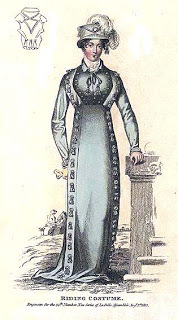 La Belle Assemblee, Riding Outfit, August,1812
La Belle Assemblee, Riding Outfit, August,1812
Made of ladies habit cloth or Maria Louisa Blue, trimmed down each side of the front with Spanish buttons, the waist rather long with three small buttons on the hips; a short jacket full behind, the front habit fashion with small buttons up the neck and a row of small buttons on each side of the breast; a lapel thrown back from the shoulders and trimmed with Spanish buttons, has a most elegant effect and gives a graceful finish to the dress. The collar is made about a quarter inch in depth and fashioned negligently at the throat with a large cord and tassel; it opens sufficiently to display the shirt which is of lace in general but this article admits of considerable variations; some of our elegants wear a collar of lace to fall over, others have a shirt edged round the neck with a rich lace frill and not a few, in despite of the heat of the weather, envelope their necks in a large cravat of India muslin. A small woodland hat, whose colour corresponds with the dress with two white ostrich feathers fastened behind and falling carelessly over the left side. A cord and tassel is brought round the hat and fastened near the top of the crown on the right side. Buff gloves and half boots either of buff jean or leather.
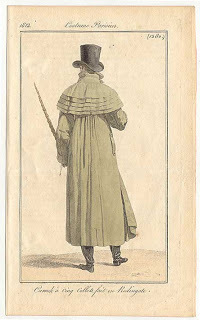 Costume Parisienne, 1812: Five-collared Carriage Coat (Redingote)
Costume Parisienne, 1812: Five-collared Carriage Coat (Redingote)

At the end is a greatcoat for a gentleman to wear in the cool weather.
Thanks to Sue Forgue at the Regency Encyclopedia for some of the descriptions I was missing.
 Ladies Monthly Museum, April 1812
Ladies Monthly Museum, April 1812The Full Dress (left), for this month, is made of white satin, ornamented round the bottom with a rich Grecian border, over which is worn a tunic of yellow Italian gauze, trimmed with deep white lace, and fastened up the front with cord of blue silk. Head dress à la Diana, ornamented with wreathes of artificial flowers in dead gold, with a crescent in front of the forehead, composed of pearls and sapphire; the necklace and ear rings to correspond; kid gloves and shoes of pale pink.
The Walking Dress (right) is a white Indian robe of Muslin, made high in the neck; with a richly worked collar to turn over that of the pelisse, which is of blue silk, trimmed with white lace; over which is worn a white,or coloured shawl; the bonnet to be of the same materials as the shawl, and is ornamented with a white feather;--laced half boots of regency brown.
 Ackermann's Repository Morning Dress April 1812
Ackermann's Repository Morning Dress April 1812A superfine Scotch or French cambric, over a cambric slip, with full long sleeves, and ruff à la Mary Queen of Scots. A neck-chain and sight set in gold; bracelets and necklace of white or red cornelian. A Flora cap, composed of white satin and lace. A capuchin or French cloak of blossom satin or Pomona green, trimmed with thread lace. Slippers of pale pink or green kid; and gloves of tan or Limerick kid.
 Ackermann's Repository, Ball Gown, April, 1812
Ackermann's Repository, Ball Gown, April, 1812A round ciracassian robe of pink crape, or gossamer net, over a white satin slip, fringed full at the feet; a peasant's bodice, of pink satin or velvet, laced in front with silver, and decorated with the same ornament. Spanish slash sleeve, embellished with white crape foldings, and furnished at its terminations with bands of silver. A Spartan or Calypso helmet cap, of pink frosted crape, with silver bandeaus, and embellished with tassels, and rosets to correspond. A rich neck-chain and ear-rings of Oriental gold. Fan of carved ivory. Slippers of pink kid, with correspondent clasps; and gloves of white kid: an occasional square veil of Mechlin lace
 Ackermann's Repository, Morning Dress, May 1812
Ackermann's Repository, Morning Dress, May 1812A French frock of fine plain India muslin, with demi-train, and long full bishop's sleeves. Waggoners' cuffs, with gaged front, and shoulders to correspond. Tucker of double-rolled muslin, which also finishes the cuffs round the hands. A Parisian mob cap of fine lace, confined round the head, and terminating on one side with a celestial blue or silver grey ribbon. Sash of the same, tied in small bows and ends in front. Hair in waved curls, divided in the center of the forehead. Spanish slippers of lemon-coloured kid, and gloves of the same material. The peculiar taste and elegant simplicity of these habiliments are further specimens of the graceful invention of the celebrated Mrs. Gill, of Cork-street, Burlington-gardens, from whom we have obtained them.
 Ackermann's Repository, June 1812
Ackermann's Repository, June 1812A round robe of jaconot or fine cambric muslin, with long sleeve and high waist, with fan ruff of lace, ornamented up the front with borders of needle-work or lace, and finished at the feet with ball fringe. A Spanish hussar clock of deep amber sarsnet, lined with sea green or white, and trimmed with broad thread lace, put on very full. Hair disposed in bands and waved curls; a large square veil of white lace, thrown over the head and shading the face. Half-boots amber-coloured kid, and gloves a pale primrose. Small French caps of lace, ornamented with a small cluster of spring flowers, on one side, are often seen in this style of costume, and have an appropriate and pretty effect beneath the long veil.
 Ackermann's Repository, July 1812
Ackermann's Repository, July 1812An embroidered crape round robe, decorated at the feet with a deep Vandyke fringe; short melon sleeve; bosom and back to correspond. White or blossom satin under dress. Hair a dishevelled crop, ornamented with a small cluster of the Chinese rose on each side, and confined with a comb of pearl at the back of the head. Necklace, ear-rings, and bracelets, of pearl and wrought gold. Grecian scarf of lilac silk, with embroidered variegated ends. Slippers of white satin, and gloves of French kid. Fan of imperial crape and ivory, embellished with gold antique devices.
 La Belle Assemblee, Evening Dress, April 1812
La Belle Assemblee, Evening Dress, April 1812An embroidered white crape, or fine India muslin frock, with long sleeves, and trimmed round the bottom with fine lace, set on full, worn over a blush colour satin or sarsnet slip; the frock ornamented down the front of the skirt with beads and lace in the Egyptian style. Parisian mob, worn unfastened, of puckered pink, and white crape over pink satin. Small pink satin tippet, with full plaiting of lace. Cestus of pale pink, confined by a clasp of pearl. Pink satin slippers, with white rosettes. The jewellery worn with this dress is the shaded cornelian or large pearls.
 La Belle Assemblee, Evening Dress, 1812
La Belle Assemblee, Evening Dress, 1812A robe of Imperial blue sarsnet, shot with white, with a demi train, ornamented with fine French lace down each side the front and round the bottom; the trimming surmounted by a white satin ribband; the robe left open a small space down the front, and fastened with clasps of sapphire and pearl over a white satin slip petticoat: short fancy sleeve to correspond with the ornaments of the robe. Parisian cap made open, formed of rows of fine lace and strings of pearl, the hair dressed à-la-Henriette of France, appearing between, and much separated on the forehead. Pearl necklace, and hoop earrings of the same. Scarf shawl in twisted drapery of fine white lace. White kid gloves and fan of ivory, ornamented with gold. Slippers the same colour as the robe, with white rosettes. This beautiful dress is the creation of Miss Walters, Wigmore-street, Cavendish-square
 Ladies Monthly Museum, Morning Dress, June 1812
Ladies Monthly Museum, Morning Dress, June 1812 A white jaconet muslin gown, buttoned down the front with white regency buttons and trimming formed en lozenge; handkerchief, gloves, and sandals of dragon fly green; figurante cap ornamented with a rose in front.Text from Michelle Anne Young’s Regency Rambles
 La Belle Assemblee, Riding Outfit, August,1812
La Belle Assemblee, Riding Outfit, August,1812Made of ladies habit cloth or Maria Louisa Blue, trimmed down each side of the front with Spanish buttons, the waist rather long with three small buttons on the hips; a short jacket full behind, the front habit fashion with small buttons up the neck and a row of small buttons on each side of the breast; a lapel thrown back from the shoulders and trimmed with Spanish buttons, has a most elegant effect and gives a graceful finish to the dress. The collar is made about a quarter inch in depth and fashioned negligently at the throat with a large cord and tassel; it opens sufficiently to display the shirt which is of lace in general but this article admits of considerable variations; some of our elegants wear a collar of lace to fall over, others have a shirt edged round the neck with a rich lace frill and not a few, in despite of the heat of the weather, envelope their necks in a large cravat of India muslin. A small woodland hat, whose colour corresponds with the dress with two white ostrich feathers fastened behind and falling carelessly over the left side. A cord and tassel is brought round the hat and fastened near the top of the crown on the right side. Buff gloves and half boots either of buff jean or leather.
 Costume Parisienne, 1812: Five-collared Carriage Coat (Redingote)
Costume Parisienne, 1812: Five-collared Carriage Coat (Redingote)
Published on May 23, 2012 01:00
May 21, 2012
Apsley House and it's Environs
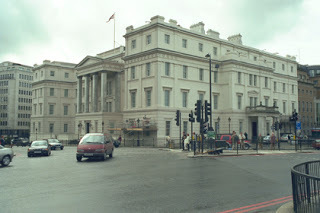
From Walks in London by Augustus Hare (1894)
At the entrance of Belgravia, opposite Hyde Park Corner, is St. George's Hospital (above, now the Lanesborough Hotel), occupying the site of Lord Lanesborough's house, which bore the couplet—'It is my delight to be
Both in town and country.' John Hunter died in the board-room of the Hospital, Oct. 16, 1793. Close by was the original site of 'Tattersall's,' now built over, formerly well known as 'The Corner,' and much frequented on Sunday afternoons, when horses and dogs were exhibited on 'The Green.' It was here that Lord Hatherton's hounds, sent up for sale, took advantage of the wicket being left open one Sunday, disappeared, and were all found safe back at Teddesley in Staffordshire next day.
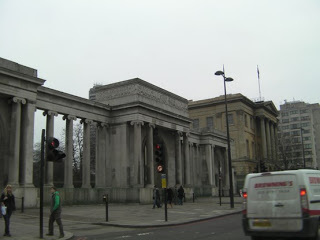 Hyde Park Gate with Apsley House to the right
Hyde Park Gate with Apsley House to the rightClose to Hyde Park Corner rises the pillared front of Apsley House (Duke of Wellington), over which, on fine afternoons, the sun long threw a spirit-like shadow from the statue of the great Duke upon the opposite gateway. The house was built in 1784 for Henry Bathurst, Lord Apsley, from designs by the brothers Adam: it was originally red brick; the stone front and portico were added in 1828. It will always excite interest from its associations as the residence of Arthur Wellesley, first Duke of Wellington, who died Sept. 14, 1852. At its gates, for many years, people used to watch for the appearance of the silver-haired veteran in his well-known blue coat and white waistcoat and trousers.'The peculiar characteristic of this great man, and which, though far less dazzling than his exalted genius and his marvellous fortune, is incomparably more useful for the contemplation of the statesman, as well as the moralist, is that constant abnegation of all selfish feelings, that habitual sacrifice of every personal, every party consideration, to the single object of strict duty—duty rigorously performed in what station soever he might be called on to act.'—Lord ErougIiam, 'Statesmen of George III.'
On the right of the Entrance Hall in Apsley House is a room appropriated as a kind of Museum of Relics of the Great Duke. It is surrounded by glass cases containing an enormous plateau, candelabra, etc., given by the Spanish and Portuguese Courts after the Peninsular War; a magnificent shield with reliefs symbolising the victories of the Duke, presented, with candelabra, by the Merchants and Bankers of London in 1822; and services of china given by the Russian, Prussian, and French Courts. In a number of table-cases are preserved the swords, batons, and orders (including the extinct order of the Saint Esprit) which belonged to the Duke; his two fieldglasses; the cloak which he wore at Waterloo; the sword of Napoleon I.; the dress worn by Tippoo Saib at his capture; and the magnificent George set with emeralds, originally given by Queen Anne to the Duke of Marlborough, and presented by George IV.
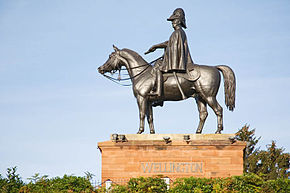
The Corinthian Arch, which forms the entrance of the Green Park, removed in 1883 from a position immediately opposite Apsley House, was erected from designs by Decimus Burton in 1828. In its former position it supported the equestrian statue of the Duke of Wellington by Wyatt (1846)—the 'hideous equestrian monster' of Thackeray. This statue, commemorating the great military achievements of the Duke, and intrusted to the keeping of the nation in 1846, was only preserved from destruction in 1883 by the spirited protest of Colonel Charles Lindsay I It was removed amid a storm of ridicule, the cocked hat being described as 'too big for the Duke, and the Duke too big for the horse, and the horse too big for everything.' It is now at Aldershot. In its place a smaller equestrian statue by Boehm has been erected. The horse is admirable in intelligent alertness, the Duke gravely observant, and the four figures at the angles of the pedestal, representing a Grenadier, Highlander, Welsh Fusilier, and Inniskillen Dragoon, are full of originality, though their taste may be questioned.
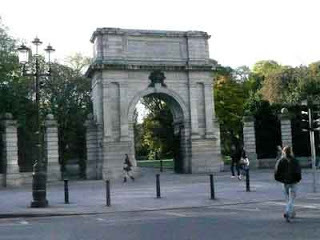
The road which passes beneath the arch leads into the Green Park (of fifty-six acres), called on some old maps Stonebridge Close, on others Upper St. James's Park. It skirts the gardens of Buckingham Palace by Constitution Hill, where no less than three attempts have been made upon the life of Queen Victoria: the first by a lunatic named Oxford, June 10, 1840; the second by Francis, another lunatic, May 30,1842; and thethird by an idiot named Hamilton, May 19, 1849. It was at the top of the hill that Sir Robert Peel was thrown from his horse, June 29, 1850, and received the injuries from which he died on the 2nd of July. The principal houses on the opposite side of the Park are Stafford House, Bridgewater House, and Spencer House. Till 1825 'the Ranger's Lodge' stood in the Park near Piccadilly: the stags which ornamented its gateway are now at Albert Gate.
Published on May 21, 2012 00:47
May 19, 2012
The Longest Reigning Monarchs
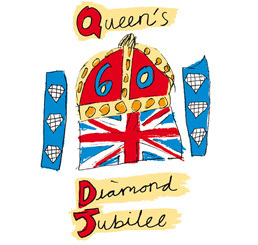
In this year celebrating the Diamond Jubilee of Queen Elizabeth II's reign, we can look back on those majestic beings who top the longevity lists for English monarchs.
Still number one is Her Imperial Majesty Victoria Regina (1819-1901) with sixty-three years, 216 days on the throne, from 1837 to 1901.
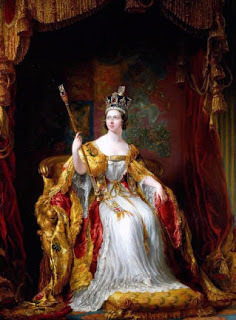 Victoria's Coronation portrait by artist George Hayter, 1837
Victoria's Coronation portrait by artist George Hayter, 1837Perfectly indicative of the incredible changes in the world during her long reign is the fact that she was portrayed at the beginning by an artist in oils and near the end by a photographer.
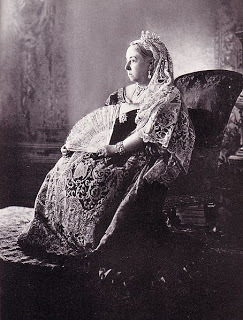 Queen Victoria's Diamond Jubilee Portrait, 1897
Queen Victoria's Diamond Jubilee Portrait, 1897She celebrated the only Royal Diamond Jubilee until this year. Below is one of the many souvenirs created for the event. Festivities took place all over the empire, as they will throughout the Commonwealth for Elizabeth II's Diamond Jubilee this year.
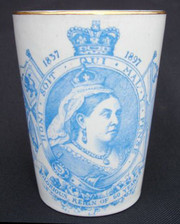
Elizabeth II was born in 1926 to the second son of King George V, the future King George VI (1895-1952) and his wife, Elizabeth Bowes-Lyon, later best known as the Queen Mother (1900-2002). The present Queen succeeded her father upon his death in 1952 and was formally crowned in 1953. Now in second place for longevity of reign, Elizabeth II might surpass Victoria's record in another four year or so.
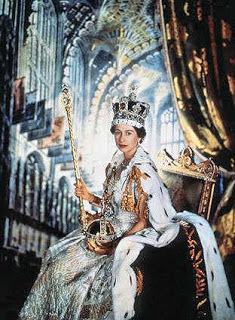 Elizabeth II in 1953
Elizabeth II in 1953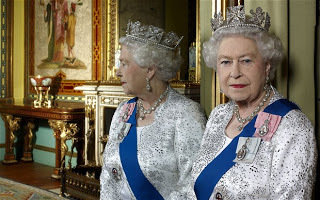 The official Diamond Jubilee Portrait by John Swannell
The official Diamond Jubilee Portrait by John Swannell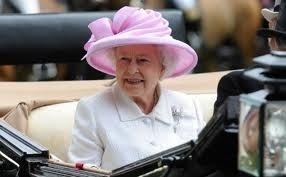 I rather prefer her in the pink hat worn at Ascot in 2011!
I rather prefer her in the pink hat worn at Ascot in 2011! Number three in longevity is George III who reigned from October 25,1760, when he was merely 22 and succeeded his grandfather George II, to January 29, 1820, though his duties had been taken over in 1811 by his son, George, Prince of Wales, as Regent.
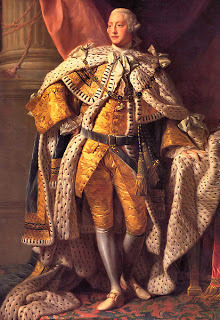 George III, by Allan Ramsay, 1762
George III, by Allan Ramsay, 1762George III is perhaps most renowned in the U.S. as the King who "lost the colonies" for his country. It is said that this fact plagued him for many years. But his eventual mental breakdowns were more likely to have been caused by inherited disease, usually attributed to porphyria, from which other members of the Hanoverian family may have suffered.
In fourth place is James I (1566-1625), because his time as James VI of Scotland is included. James I was the son of Mary, Queen of Scots (1542-1587), and was crowned King of Scotland at age 13 months in 1567. Mary was a cousin of Elizabeth I, but the two women were never to overcome the rivalries of their circles and develop a cooperative relationship. Elizabeth I (1533-1603) eventually had Mary put to death.
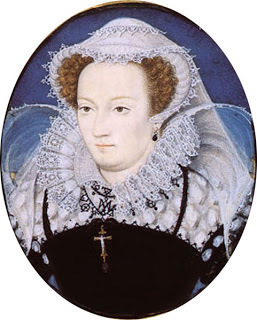 Mary, Queen of Scots, by Nicholas Hilliard, c. 1578
Mary, Queen of Scots, by Nicholas Hilliard, c. 1578Ironically, it was Mary's son James, the Scottish King, who untied Britain and Scotland and became Elizabeth I's successor, King James I.
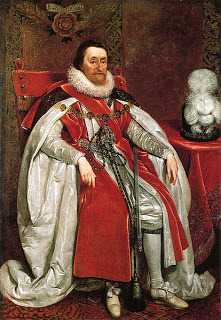 James I
James I Britain under James I continued its Renaissance flowering of literature (Shakespeare, Donne) and the arts in what became known as the Jacobean Age. The bible -- King James Version -- was translated into English; we celebrated 400 years of this great work in 2011.
The next two monarchs in longevity are Henry III (reigned 1226-1272) and Edward III (reigned 1327-1377), 56 and 50 years respectively. Next is William I of Scotland (1165-1214), followed by Llywelyn of Gwynedd (1195-c.1240).
Taking 9th place in longevity is Elizabeth I (1533-1603), who followed her sister Mary Tudor and brother Edward VI as a successor to Henry VIII. Elizabeth was age 25 when she was crowned and reigned for more than 44 years.
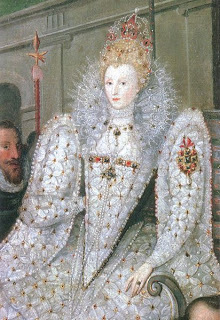 detail of Elizabethan procession, c. 1575
detail of Elizabethan procession, c. 1575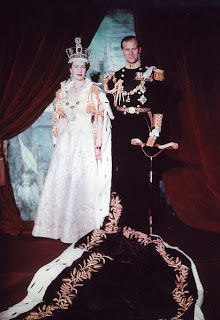
Our own Elizabethan Age began in 1952. Above is the Queen with her consort, Prince Philip, Duke of Edinburgh. The royal couple has celebrated their 64th wedding anniversary.
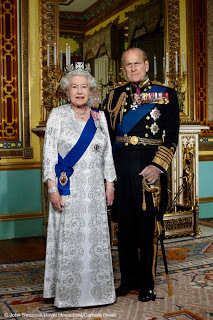 Elizabeth has been on the throne throughout the terms of office of eleven U. S. presidents, from President Eisenhower to President Obama. Congratulations and best wishes to Elizabeth II and Philip -- and all their children, grandchildren, and great grandchildren too.
Elizabeth has been on the throne throughout the terms of office of eleven U. S. presidents, from President Eisenhower to President Obama. Congratulations and best wishes to Elizabeth II and Philip -- and all their children, grandchildren, and great grandchildren too.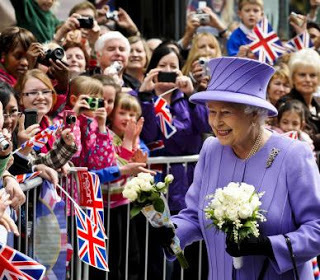 Elizabeth II and some of her subjects
Elizabeth II and some of her subjectsThe official Jubilee website is here.
Published on May 19, 2012 01:00
May 17, 2012
A Stroll Down Piccadilly
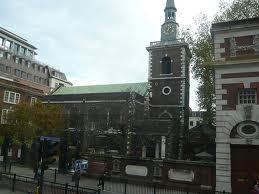
From Walks in London by Augustus Hare (1894)
Turning eastwards (out of St. James's Street and onto Piccadilly), we find, on the right, St. James's Church, built by Wren, 1684. Hideous to ordinary eyes, this church is still admirable in the construction of its roof, which causes the interior to be considered as one of the architect's greatest successes—probably his best interior, except St. Stephen's, Walbrook.
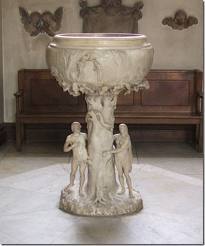
The marble font is an admirable work of Gibbons: the stem represents the Tree of Knowledge, round which the Serpent twines, offering the apple to Eve, who stands with Adam beneath. The organ was ordered by James II. for his Catholic chapel at Whitehall, and was given to this church by his daughter Marj'. The carving here was greatly admired by Evelyn.
'Dec. 10, 1684.—I went to see the new church at St. James's, elegantly built . The altar was especially adorned, the white marble inclosure curiously and richly carved, the flowers and garlands about the walls by Mr. Gibbons, in wood: a pelican, with ber young at her breast, just over the altar in the carv'd compartment and border invironing the purple velvet fringed with richly embroidered, and most noble plate, were given by Sir R. Geare, to the value (as is said) of £200. There was no altar anywhere in England, nor has there been any abroad, more richly adorned.'—Diary.
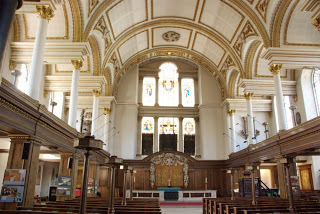
The Princess Anne of Denmark was in the habit of attending service in this (then newly built) church, and it was one of the petty insults which William and Mary offered to the Princess (after her refusal to give up Lady Marlborough) to forbid Dr. Birch, the rector, to place the text upon the cushion in her pew, an order with which the rector, an especial partisan of the Princess, refused to comply.Among the illustrious persons who have been buried here are Charles Cotton, the friend of Izaak Walton, 1687; the two painters Vandevelde, 1693 and 1707 ; Dr. Arbuthnot, the friend of Pope and Gay, the slouching satirist, of whom Swift said that he could 'do everything but walk,' 1735; Mark Akenside, the harsh doctor who wrote the 'Pleasures of Imagination,' 1770; Michael Dahl, the portrait-painter, 1743; Robert Dodsley, footman, poet, and bookseller, 1 764; the beautiful and brilliant Mary Granville, Mrs. Delany, the beloved and honoured friend of George III. and Queen Charlotte, 1788; William, the eccentric Duke of Queensberry, known as' Old Q.,' 1810; James Gillray, the caricaturist, 1815; and Sir John Malcolm, Governor of Bombay, 1833.i In the vestry are portraits of most of the rectors of St. James's, including Tenison, Wake, and Seeker, who were afterwards Archbishops of Canterbury.
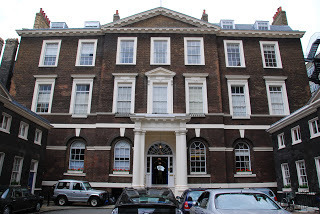
On the other side of Piccadilly, nearly opposite the church, are the Albany Chambers (above), which take their name from the second title of Frederick, Duke of York, second son of George II., to whom the principal house (first known as Melborne, then as York House) once belonged. 'The Bachelor of the Albany' was a character well known at the beginning of the present century.'In the quiet avenue of the Albany (Albany court Yard), memories of the illustrious dead crowd upon you. Lord Byron wrote his "Lara" here, in Lord Althorpe's chambers, afterwards (1837) occupied by Lord Lytton; George Canning lived at A. 5, and Lord Macaulay in E. 1; Tom Duncombe in F. 3; Lord Valentia, the traveller, in H. 5, and Monk Lewis in K. 1.'—Blanchard Jerrold.
Sackville Street, which opens on the north, has the distinction of no standard lamps, retaining the first form of gas-lamp, projecting from the walls of the houses.
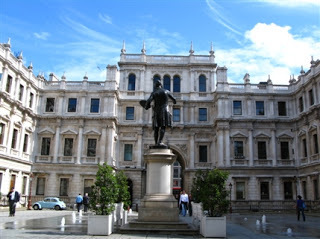
On the right, in returning, is Burlington House (now the Royal Acadamy of Arts, above), built from designs of Banks and Barry, 1868-74. The inner part, towards the courtyard, is handsome; that towards the street, and the sides of the building, are spoilt by the heavy meaningless vases by which they are overladen. In the construction of this commonplace edifice one of the noblest pieces of architecture in London was wantonly destroyed—the piazza, of which Sir William Chambers wrote as 'one of the finest pieces of architecture in Europe,' and which Horace Walpole said 'seemed one of those edifices in fairy-tales that are raised by genii in a night-time.' Its stones were removed to Battersea Park, but London, which has spent £10,696 on the Temple Bar Memorial, has never been able to afford the sum necessary for their reconstruction!The old house (the second on the site) was built from the designs of Richard Boyle, third Earl of Burlington, but the portico has been attributed to Colin Campbell. Burlington House was bought by the nation in 1854. The central portion of the modern buildings is devoted to the Royal Academy, which was founded in 1768, with Reynolds as President. It consists of forty Academicians and thirty-one Associates. Their first exhibitions took place in Somerset House, but, from 1838 to 1854, they were held in the eastern wing of the National Gallery. How great was their early mediocrity may be seen from the cuttings in vellum and paper, landscapes in human hair, and devices in shell-work described in Exhibition catalogues of the last century, though these were interspersed with great works by Reynolds and Flaxman.In Cork Street, facing the back of Burlington House, General Wade's house was built by Richard Boyle, Earl of Burlington, a house which was so uncomfortable as to make Lord Chesterfield say that the owner could not be at his ease in it, and so intended to take the house over against it and loot at it. The famous tavern of the 'Blue Posts' in this street has been recently rebuilt.
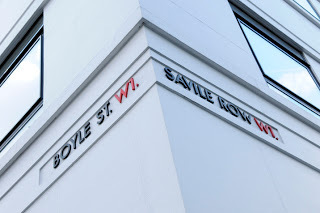
From the end of Savile Row, an archway and passage lead into Conduit Street, through what was once the two-winged garden pavilion of Burlington House, the countrified position of which in the seventeenth century was chosen by its founder 'because he was determined that no one should build beyond him.' All the streets in this neighbourhood—Cork Street, Old and New Burlington Street, and Boyle Street—record the names and titles of the Boyle family. In Boyle Street still stands the school founded by Lady Burlington, on the edge of her gardens, for the maintenance and education of eighty poor girls.
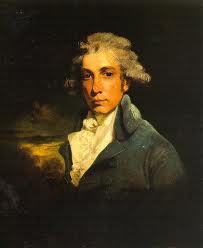
Hard by, in Savile Row (named from Dorothy Savile, wife of the architect Earl of Burlington), at No. 12, George Grote, the historian of Greece, died, June 19, 1871; at No. 17 Richard Brinsley Sheridan (above) died, July 7, 1816. His so-called friends suffered him to be arrested by a sheriff's officer upon his death-bed, and he would have been carried off, in his blankets, to a spunging-house, if his physician had not threatened the officer with the responsibility of his dying on the way; yet seldom has there been such an array of rank as when he was borne hence to his grave in Westminster Abbey!
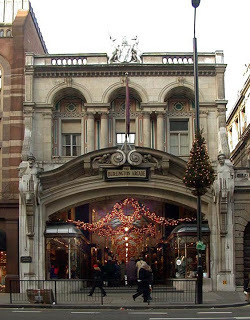
The Burlington Arcade (above) was built from designs by Ware for Lord George Cavendish in 1815, and is 'famous,' as Leigh Hunt says, 'for small shops and tall beadles.' Just beyond, in Piccadilly, was the little underground newsvendor's, whither Louis Napoleon Bonaparte 'would stroll quietly from his house in King Street, St. James's, in the evening, with his faithful dog Ham for his companion, to read the latest news in the latest editions of the papers.'
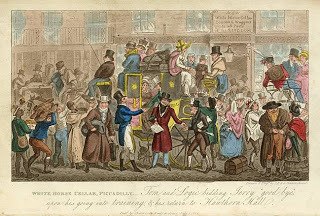
In old times this was the celebrated 'White Horse Cellar,' where might be seen what Hazlitt calls 'the finest sight in the metropolis,' the starting of the coaches in Piccadilly. Latterly there has been a revival of the love of the road, and a number of coaches (frequently with amateur drivers) in Northumberland Avenue attract the enthusiasm of a little crowd on their morning departures and their evening arrivals. Bond Street, Albemarle Street, Dover Street, and Grafton Street occupy the site of Clarendon House and its gardens, built by the Lord Chancellor Earl of Clarendon, who laid out the gardens at a cost of £50,000.
Published on May 17, 2012 00:03
May 15, 2012
In The English Garden
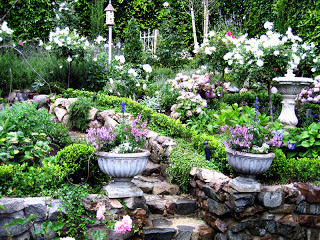
Gardeners the world over seek to re-create their own patch of Englishness by way of a garden. No matter where in the world one lives, it is possible to obtain such quintessentially English plants as lavender, hollyhocks and roses. One can even go so far as to install hedgerows, herbaceous borders and a ha-ha in the garden. But it occurred to me that what really sets an English garden apart are the things one finds in the garden, decoration-wise. A few urns or a lichen covered bit of crumbling statuary are both fine and dandy, but nothing says "English garden" quite like a dovecote or, say, a hen house. In fact, you could do worse than to take a page from the Duchess of Devonshire's book and get yourself an entire flock of fowl. To that end, we've taken a stroll around the internet and rounded up a host of unique - and beautiful - garden decorations on offer for feathered friends.
The Dorset based company Flytes of Fancy offer Gypsy hen houses in such themes as the Willow, below
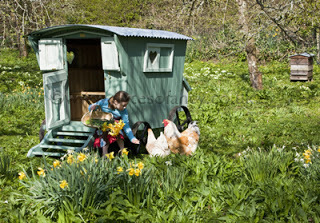
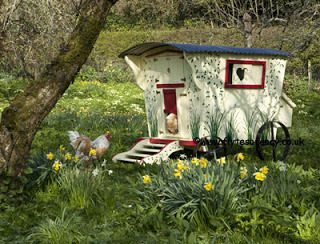
The Gypsy Daydream, above, is offered at £3900.00, depending on any additional bespoke requirements and your delivery preferences. Each henhouse is hand-painted by the resident artist and can be further customized to your specifications.
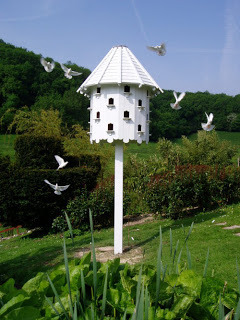
The Branscombe model dovecote, above, available from http://www.dovecotes.co.uk/, offers four storeys of living space for 20 to 24 pair of doves. No doves? No problem . . . . whilst called "dovecotes" these houses have always been used to more commonly house pigeons.
Marks Dovecotes offer even more variety in dovecote construction, including the Westminster Slate model shown here
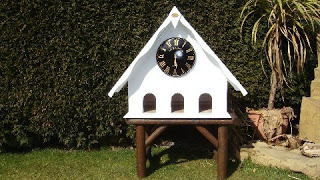
Should you not be a fan of either hens or doves, have no fear - Marks Dovecotes also offer a duck house

Should you wish to house smaller feathered friends, this birdhouse from the Highgrove Shop is just the ticket
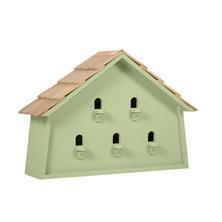
Looking to attract a particular species of bird? The Patch birdiebox below, from Garden Loverz, features a lever on the front gives you control over the type of birds you would like to nest in your garden.

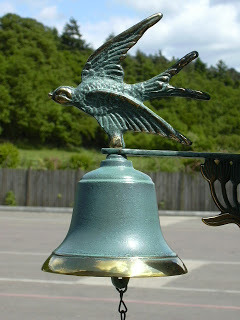
Finally, we just couldn't resist showing you this Flying Bird porch bell in a verdigris finish available from Gifts and Gardens.
Published on May 15, 2012 00:05
May 13, 2012
A Day with JASNA-GCR
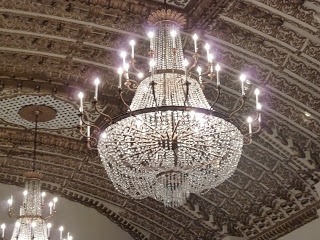
On May 5, in the Crystal Ballroom of Chicago's Millennium Knickerbocker Hotel, JASNA-GCR (Jane Austen Society of North America, Greater Chicago Chapter) held its Spring Gala, Chawton Comes to Chicago, a day of excellent presentations, good food, shopping, meeting and greeting old friends and new.

Jeff Nigro, JASNA-GCR's regional coordinator, welcomed everyone and enumerated the events of the day.
Elizabeth Garvie, long a favorite of Janeites as the "real" Elizabeth Bennett for her role in the 1980 BBC version of Pride and Prejudice, gave a charming performance of selections from Jane Austen's life and works, "Jane Austen Delights."
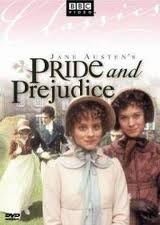
I particularly enjoyed her reading from Lesley Castle (from the Juvenilia), in which the writer of a letter pleads with her correspondent for pity over her disappointment at having prepared a wedding feast which could not now be eaten as intended because the groom had been stuck down, completely ignoring the real tragedy. She thinks only of her own wasted expense and effort -- and how they will ever consume the victuals she has prepared. The ironic humor of the passage has never before struck me with such vivid force.
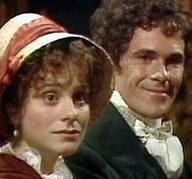 Elizabeth Garvie and David Rintoul as Lizzy and Darcy
Elizabeth Garvie and David Rintoul as Lizzy and DarcyClearly the audience's favorite part of the performance was Ms. Garvie's portrayal of Emma's Miss Bates. Every nuance of the lady's overwrought arrival at the ball (Ch. 38) was perfectly articulated and left us all laughing and applauding. We could have listened all day! Despite the fact that Ms. Garvie has played innumerable characters by a wide variety of authors since her turn as Lizzy Bennet, we were all convinced of her special affinity for the works of Jane Austen.
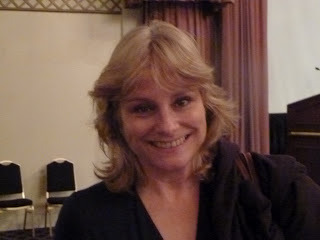 Elizabeth Garvie
Elizabeth GarvieAuthor Lindsay Ashford told the story of how she moved to Chawton and became immersed in the life and times of Jane Austen. As she learned more and more about the writer, reading in the very rooms in which Jane herself might have read, eating where she would have frequently dined, Ashford was more and more obsessed with Austen and her early death at a mere age 41.
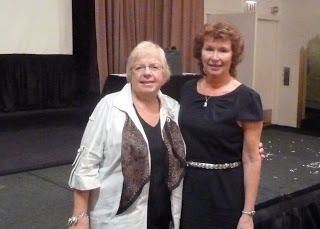 Victoria Hinshaw and Lindsay Ashford
Victoria Hinshaw and Lindsay AshfordWhen she learned arsenic had been detected in an analysis of a lock of Jane's golden hair, her imagination took flight. Could the author -- - also beloved daughter, sister and aunt -- have been murdered with arsenic? And by whom? Now Ashford has published The Mysterious Death of Miss Austen, a novel in which this is exactly what happens. Written from the point of view of Jane's dear friend Miss Anne Sharp, once the governess to Edward Austen's children, the novel has enjoyed considerable attention around the world.
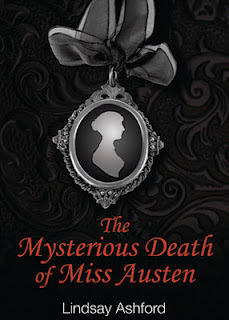
Ashford is the partner of Steve Lawrence, CEO of the Chawton House Library. Below they are pictured in the costume promenade at last October's Fort Worth, TX, JASNA AGM.
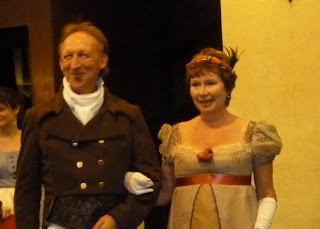
Following Ashford's talk, Steve Lawrence brought us up to date on activities at Chawton House Library, showing pictures of the latest projects, such as the "new" 18th C. barn discovered nearby and rebuilt on the edge of the property.
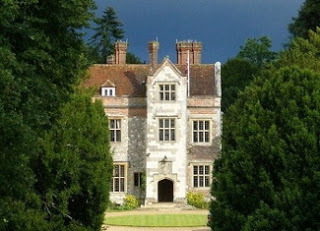
It seems impossible that the library is already about to celebrate it's tenth anniversary. Where have all these years gone? On the other hand, it his hard to imagine the world in the village of Chawton, of Austen studies, or of on-line availability of many heretofore impossible-to-find novels without the library and its holdings. For more information, here is the website.
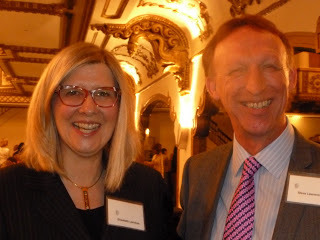 JASNA-GCR Program Chair Elisabeth Lenckos and Steve Lawrence
JASNA-GCR Program Chair Elisabeth Lenckos and Steve LawrenceThe luncheon was enjoyed by all, and featured short readings from works by four members of the organization -- whose writings are "inspired" by Jane Austen.
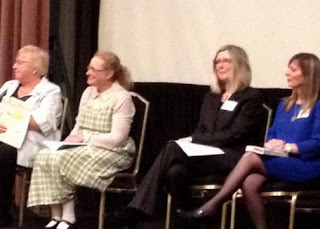 JASNA-GCR Readers
JASNA-GCR ReadersVictoria Hinshaw read from her novel The Fontainebleau Fan; Holly Bern read from her story "People of the Book" in Wooing Mr. Wickham," a collection of prize-winning stories chosen in a Chawton House Libary contest and edited by Lindsay Ashford; Elisabeth Lenckos read from her story, "Jane Austen 1945," also a winner in the Wooing Mr. Wickham collection; and Karen Doornebos read a selection from her novel Definitely Not Mr. Darcy. Karen's website is here.
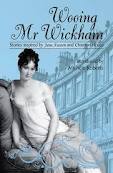
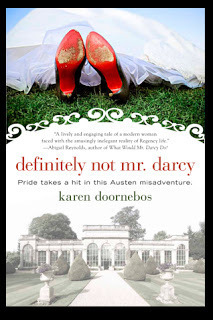
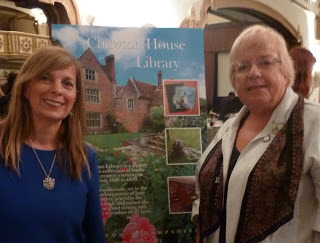 Karen and Victoria with a Chawton House Library poster
Karen and Victoria with a Chawton House Library poster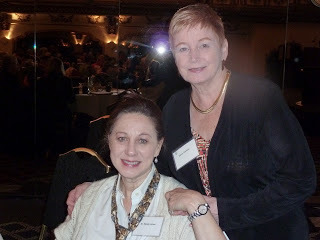 Sandy Lerner, seated, and Diane Capitani, JASNA-GCR education outreach coordinator
Sandy Lerner, seated, and Diane Capitani, JASNA-GCR education outreach coordinatorDr. Sandy Lerner, aka Ava Farmer, author of Second Impressions, related her experience fulfilling her long-held ambition of writing a sequel to her favorite novel, Pride and Prejudice. One of her motivations for assembling the collection of books which form the nucleus of the Chawton collection today was to immerse herself in the world and sensibilities of Jane Austen's times, aimed at finishing that novel. It was published recently, and is available everywhere.
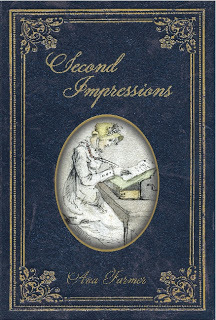
Dr. Lerner is the founder and benefactor of the Chawton House Library; all proceeds from the sale of Second Impressions are donated to the library. She told us of her many acquisitions of novels by early women writers whose work, while popular at the time, was never catalogued in libraries or preserved in any organized fashion. She particularly was interested in works such as letters and diaries which might never have been published but had been saved among family papers. Of particular note, she said, were accounts of travels in the 18th and early 19th centuries, often recorded for the enjoyment of family members.
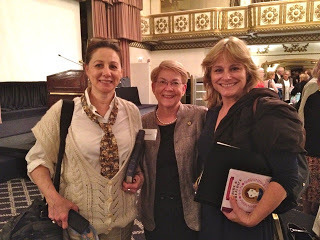 Sandy Lerner; Marsha Huff, past president of JASNA; Elizabeth Garvie
Sandy Lerner; Marsha Huff, past president of JASNA; Elizabeth Garvie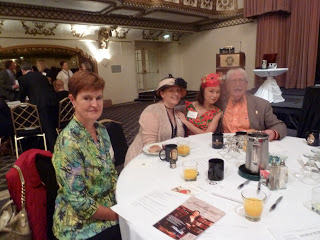 Gail Murphy, Laura Whitlock, Debra Miller and William Phillips enjoy the program.
Gail Murphy, Laura Whitlock, Debra Miller and William Phillips enjoy the program.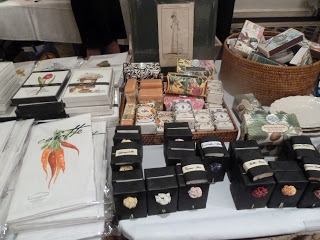 Tempting our pocketbooks were lovely items from Vintage Pine (http://www.vintagepine.com/), Figaro Interiors, and Jane Austen Books (http://www.janeaustenbooks.net/).
Tempting our pocketbooks were lovely items from Vintage Pine (http://www.vintagepine.com/), Figaro Interiors, and Jane Austen Books (http://www.janeaustenbooks.net/).The lively and active JASNA-GCR group has recently updated its website, here. Please visit soon.
Published on May 13, 2012 01:00
May 11, 2012
Ashton on the Assassination of P.M. Perceval, May 11, 1812
Spencer Perceval (1762-1812) had been Prime Minister for three years when he was shot in the lobby of the House of Commons, May 11, 1812. He is the only British Prime Minister to have been assassinated.
Excerpt from John Ashton's Social England Under the Regency, chapter 6:
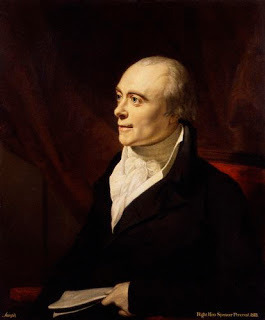 Perceval by George Francis Joseph, NPG
Perceval by George Francis Joseph, NPG
One of the principal social events of the year was the Murder of the Right Hon. Spencer Perceval, Chancellor of the Exchequer, First Lord of the Treasury, and Prime Minister of England, who was shot by the hand of an assassin, John Bellingham, on the 11th of May, whilst passing through the lobby of the House of Commons. He was born November 1, 1762, so that, when he fell, he was in the prime of life. He was of very good family, being the second son of John, Earl of Egmont, in Ireland, and Baron Lovel and Holland in England. His family was one of the very few that really came over with the Conqueror, for Robert, the second son of Eudes, sovereign Duke of Brittany, settled in Normandy, and there became possessed of the lordships of Brewehal and Ivery. As stated, he came over in the Norman filibuster's suite, and in the course of two or three generations the name of Brewehal, became changed into Perceval-and ever afterwards so remained.
Spencer Perceval, studied for, and practiced at, the Bar, being made King's Counsel in 1796. In the same year, his first cousin, Lord Compton, who was a member for Northampton, succeeded to his father's title of Earl of Northampton; and Perceval, offering himself for the vacant seat, was elected without opposition. His rise was rapid, and in 1801, being then in his 39th year, he joined Lord Addington's Government as Solicitor-General. In 1802 he was made Attorney-General. When Pitt resumed the government, he retained his appointment, but resigned it at Pitt's death.
In Lord Portland's Ministry of 1807, he undertook the duties of Chancellor and Under Treasurer of the Exchequer, and also Chancellor of the Duchy of Lancaster. In October, 1809, he was First Lord of the Treasury, and Prime Minister, and so continued until his sad end.
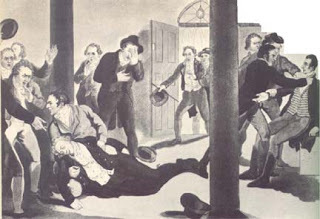 recreation of the assassination scene
recreation of the assassination scene
One may well ask why did Bellingham shoot Perceval? To this day I cannot tell. In the year 1804, a Mr. John Bellingham-who had been brought up in a Counting House in London, and, afterwards, lived three years as clerk with a Russian Merchant at Archangel, whence he had returned to England-went back to Russia on Mercantile business-was there twice imprisoned-he said falsely-and treated, according to his own account, with very great indignity. He complained to the British Ambassador at Petersburg, and also to the Secretary of Legation, but did not obtain his desired redress. He returned to England in 1809, as he said, ruined in health and fortune. But the British Ambassador, Lord Gower, declared that he used all the influence he possessed (with propriety) in Bellingham's favour; but that he was legally imprisoned for debt, upon the award of four arbitrators, two of them British Merchants chosen by himself, and the other two Russians; that his confinement was far from severe; that he was allowed to walk at large, only under the inspection of a police officer; and that he had received help in money from the Secretary of Legation.
But he was "a man with a grievance," and went about to different branches of the Government, detailing the laches of Lord Gower and the Secretary, for their culpable neglect in not looking properly after the interests of a British subject. He then determined to bring his case before Parliament, and asked General Gascoyne to back his petition, and the General promised to do so, provided it had the countenance of Mr. Perceval, the Chancellor of the Exchequer, which was considered necessary in all cases which involved a pecuniary grant.
He wrote to poor Perceval for leave to bring in a petition, but was answered that Mr. Perceval thought that his petition "was not of a nature for the consideration of Parliament." Then he went to the Regent and the Privy Council, but to no purpose: made applications all round, but met with no good, except a reference to the Chancellor of the Exchequer; but here he had been refused help. Then he wrote a letter to the Bow Street Magistrates, stating his case-saying that he would, once more solicit his Majesty's Ministers, through them, and failing redress from that, he continued, "I shall then feel justified in executing justice myself; in which case, I shall be ready to argue the merits of so reluctant a measure, with his Majesty's Attorney-General, wherever, and whenever I may be called upon to do so. In the hopes of averting so abhorrent but compulsive an alternative,--I have the honour to be &c&c." The Magistrates communicated the contents of this packet to the Secretary of state, but it only resulted in a fresh disappointment.
He still kept on trying, and his idea of taking vengeance on some one, increased, until it not only became fixed, but he planned its carrying out. He had a pocket made in his coat of a peculiar size and shape, in order to carry a pistol; and on the fatal 11th of May, he hid himself behind one of the folding doors of the lobby of the House of Commons; and when, about a quarter past five, the ill-fated Chancellor made his appearance, Bellingham shot him through the heart. Poor Perceval only reeled a pace or two, faintly called out, that he was murdered, and then fell. . . .
He was equally calm when brought before the bar of the House, acknowledging the fact, and even attempting to justify it. He was committed to Newgate, where two men were constantly with him in his cell, to prevent any attempt at self-destruction. He was brought up for trial at the Old Bailey on the 15th of May. The facts against him were concisely and clearly stated, even to that of his having his pockets specially made to hold the pistols; and he conducted his own defence. He gave an account of his sufferings for the past eight years, laying the blame principally on Lord Leveson Gower, whom he regretted he had not killed in place of Mr. Perceval. "He as obliged to the Attorney-General and the Court for setting aside the plea of insanity urged by his counsel, and could assure them, whenever he should appear before the tribunal of God, he should be adjudged innocent of the willful murder of Mr. Perceval. That he perished by his hand he admitted; but, to constitute felony, there must be malice prepense, the willful intention, which had not been proved. In this case, he had been robbed of his property, his family ruined, and his mind tortured through the conduct of Government Agents; and he was now to answer for his life, because Mr. Perceval chose to patronize iniquity, and refuse him redress."
Of course, this style of argument availed him nothing with the jury, who, after a very brief consultation, brought him in "Guilty." Sentence of death was passed upon him, and as there was very little sickly sentimentality in those days, as to carrying out the penalty of the law, he was duly hanged on the 18th of May; his body being given over to the surgeons for dissection. It is said that after his body was opened, his heart continued its functions for four h ours; in other words that he was living for that time.
The day after Mr. Perceval's assassination, the Prince Regent sent a Message to Parliament recommending a provision being made for Mrs. Perceval and her family, and an annuity of 2,000 pounds was granted her, together with a sum of 30,000 pounds to her family. These were voted unanimously, and two other votes were passed by large majorities-one to provide a monument to his memory in Westminster Abbey, the other granting to his eldest son, Spencer Perceval, who was just about to go to College, an annuity of 1,000 pounds, from the day of his father's death, and an additional 1,000 yearly, on the decease of his mother.
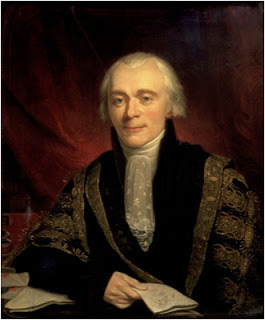 Perceval, also by artist Joseph
Perceval, also by artist Joseph
One would have thought that there could have been but one feeling throughout the nation, that of horror, at this dastardly murder, but one town was the base exception. When the news of his murder reached Nottingham, a numerous crowd publicly testified their joy by shouts, huzzas, drums beating, flags flying, bells ringing, and bonfires blazing. The Military being called out, and the Riot Act read, peace was restored.
Excerpt from John Ashton's Social England Under the Regency, chapter 6:
 Perceval by George Francis Joseph, NPG
Perceval by George Francis Joseph, NPGOne of the principal social events of the year was the Murder of the Right Hon. Spencer Perceval, Chancellor of the Exchequer, First Lord of the Treasury, and Prime Minister of England, who was shot by the hand of an assassin, John Bellingham, on the 11th of May, whilst passing through the lobby of the House of Commons. He was born November 1, 1762, so that, when he fell, he was in the prime of life. He was of very good family, being the second son of John, Earl of Egmont, in Ireland, and Baron Lovel and Holland in England. His family was one of the very few that really came over with the Conqueror, for Robert, the second son of Eudes, sovereign Duke of Brittany, settled in Normandy, and there became possessed of the lordships of Brewehal and Ivery. As stated, he came over in the Norman filibuster's suite, and in the course of two or three generations the name of Brewehal, became changed into Perceval-and ever afterwards so remained.
Spencer Perceval, studied for, and practiced at, the Bar, being made King's Counsel in 1796. In the same year, his first cousin, Lord Compton, who was a member for Northampton, succeeded to his father's title of Earl of Northampton; and Perceval, offering himself for the vacant seat, was elected without opposition. His rise was rapid, and in 1801, being then in his 39th year, he joined Lord Addington's Government as Solicitor-General. In 1802 he was made Attorney-General. When Pitt resumed the government, he retained his appointment, but resigned it at Pitt's death.
In Lord Portland's Ministry of 1807, he undertook the duties of Chancellor and Under Treasurer of the Exchequer, and also Chancellor of the Duchy of Lancaster. In October, 1809, he was First Lord of the Treasury, and Prime Minister, and so continued until his sad end.
 recreation of the assassination scene
recreation of the assassination sceneOne may well ask why did Bellingham shoot Perceval? To this day I cannot tell. In the year 1804, a Mr. John Bellingham-who had been brought up in a Counting House in London, and, afterwards, lived three years as clerk with a Russian Merchant at Archangel, whence he had returned to England-went back to Russia on Mercantile business-was there twice imprisoned-he said falsely-and treated, according to his own account, with very great indignity. He complained to the British Ambassador at Petersburg, and also to the Secretary of Legation, but did not obtain his desired redress. He returned to England in 1809, as he said, ruined in health and fortune. But the British Ambassador, Lord Gower, declared that he used all the influence he possessed (with propriety) in Bellingham's favour; but that he was legally imprisoned for debt, upon the award of four arbitrators, two of them British Merchants chosen by himself, and the other two Russians; that his confinement was far from severe; that he was allowed to walk at large, only under the inspection of a police officer; and that he had received help in money from the Secretary of Legation.
But he was "a man with a grievance," and went about to different branches of the Government, detailing the laches of Lord Gower and the Secretary, for their culpable neglect in not looking properly after the interests of a British subject. He then determined to bring his case before Parliament, and asked General Gascoyne to back his petition, and the General promised to do so, provided it had the countenance of Mr. Perceval, the Chancellor of the Exchequer, which was considered necessary in all cases which involved a pecuniary grant.
He wrote to poor Perceval for leave to bring in a petition, but was answered that Mr. Perceval thought that his petition "was not of a nature for the consideration of Parliament." Then he went to the Regent and the Privy Council, but to no purpose: made applications all round, but met with no good, except a reference to the Chancellor of the Exchequer; but here he had been refused help. Then he wrote a letter to the Bow Street Magistrates, stating his case-saying that he would, once more solicit his Majesty's Ministers, through them, and failing redress from that, he continued, "I shall then feel justified in executing justice myself; in which case, I shall be ready to argue the merits of so reluctant a measure, with his Majesty's Attorney-General, wherever, and whenever I may be called upon to do so. In the hopes of averting so abhorrent but compulsive an alternative,--I have the honour to be &c&c." The Magistrates communicated the contents of this packet to the Secretary of state, but it only resulted in a fresh disappointment.
He still kept on trying, and his idea of taking vengeance on some one, increased, until it not only became fixed, but he planned its carrying out. He had a pocket made in his coat of a peculiar size and shape, in order to carry a pistol; and on the fatal 11th of May, he hid himself behind one of the folding doors of the lobby of the House of Commons; and when, about a quarter past five, the ill-fated Chancellor made his appearance, Bellingham shot him through the heart. Poor Perceval only reeled a pace or two, faintly called out, that he was murdered, and then fell. . . .
He was equally calm when brought before the bar of the House, acknowledging the fact, and even attempting to justify it. He was committed to Newgate, where two men were constantly with him in his cell, to prevent any attempt at self-destruction. He was brought up for trial at the Old Bailey on the 15th of May. The facts against him were concisely and clearly stated, even to that of his having his pockets specially made to hold the pistols; and he conducted his own defence. He gave an account of his sufferings for the past eight years, laying the blame principally on Lord Leveson Gower, whom he regretted he had not killed in place of Mr. Perceval. "He as obliged to the Attorney-General and the Court for setting aside the plea of insanity urged by his counsel, and could assure them, whenever he should appear before the tribunal of God, he should be adjudged innocent of the willful murder of Mr. Perceval. That he perished by his hand he admitted; but, to constitute felony, there must be malice prepense, the willful intention, which had not been proved. In this case, he had been robbed of his property, his family ruined, and his mind tortured through the conduct of Government Agents; and he was now to answer for his life, because Mr. Perceval chose to patronize iniquity, and refuse him redress."
Of course, this style of argument availed him nothing with the jury, who, after a very brief consultation, brought him in "Guilty." Sentence of death was passed upon him, and as there was very little sickly sentimentality in those days, as to carrying out the penalty of the law, he was duly hanged on the 18th of May; his body being given over to the surgeons for dissection. It is said that after his body was opened, his heart continued its functions for four h ours; in other words that he was living for that time.
The day after Mr. Perceval's assassination, the Prince Regent sent a Message to Parliament recommending a provision being made for Mrs. Perceval and her family, and an annuity of 2,000 pounds was granted her, together with a sum of 30,000 pounds to her family. These were voted unanimously, and two other votes were passed by large majorities-one to provide a monument to his memory in Westminster Abbey, the other granting to his eldest son, Spencer Perceval, who was just about to go to College, an annuity of 1,000 pounds, from the day of his father's death, and an additional 1,000 yearly, on the decease of his mother.
 Perceval, also by artist Joseph
Perceval, also by artist JosephOne would have thought that there could have been but one feeling throughout the nation, that of horror, at this dastardly murder, but one town was the base exception. When the news of his murder reached Nottingham, a numerous crowd publicly testified their joy by shouts, huzzas, drums beating, flags flying, bells ringing, and bonfires blazing. The Military being called out, and the Riot Act read, peace was restored.
Published on May 11, 2012 01:00
May 9, 2012
Walking St. James, Part Two
Victoria here, continuing my walk through parts of St. James...I reached Marlborough House, once the residence of Edward, Prince of Wales (later Edward VII), and his wife Alexandra of Denmark.
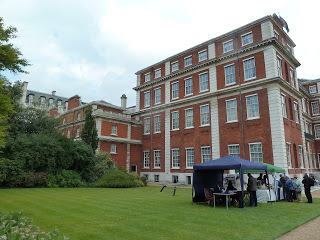
Since it was not only the day of Trooping the Colour but also part of the Open Squares weekend, the gardens of Marlborough House were open to the public. It is now the home of the Commonwealth Secretariat and Conference Center. The tents shown above not only dispensed hot tea, a necessity on this chilly day, but also displayed brochures and booklets on the 54 member nations of the Commonwealth. Anyone for a vacation in Tasmania?
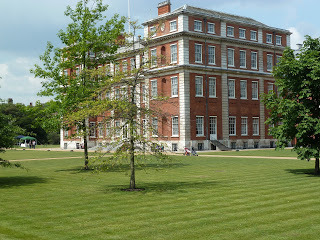
Marlborough House was built for Sarah Churchill, first Duchess of Marlborough by Sir Christopher Wren, closely bordering the grounds of St. James Palace. Eventually the house was taken up by the crown and used by various members of the royal family. For many years, as the residence of Edward and Alexandra, it was the home of the Marlborough Set, a late Victorian social circle around the Prince of Wales.
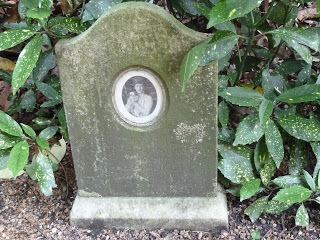
My favorite feature of these gardens was most definitely the Pet Cemetery where Alexandra's dear little dogs are buried in a corner.
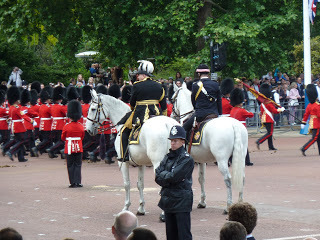
I walked to the opposite corner of the gardens and watched the troops escorting the Queen back to Buckingham Palace. I stood on a mound inside the wall that gave an excellent views, only partially blocked by the police and mounted officers along the route.
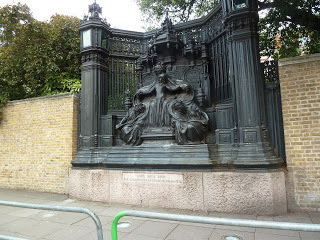
A memorial to Queen Alexandria is built into the garden wall of Marlborough House, just opposite St. James Palace.
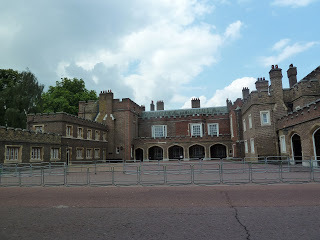 East facade of St. James, facing the grounds of Marlborough House
East facade of St. James, facing the grounds of Marlborough House
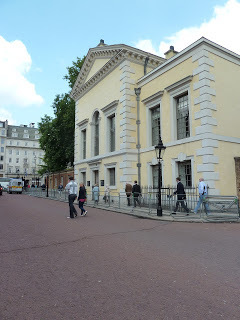 Queen's Chapel, opposite St James Palace, north of Marlborough House
Queen's Chapel, opposite St James Palace, north of Marlborough House
The Queen's Chapel was built for Henrietta Maria, wife of Charles I, in 1625 and designed by Inigo Jones. It is used for services at various times of the year that are open to the public. It was originally Roman Catholic but is now Church of England.
I walked around the corner of St. James Palace to the more familiar facade of the palace which faces north, up St. James St. toward Piccadilly.
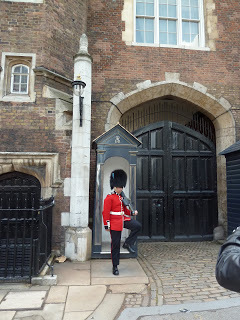
From here on, the royal connections are more limited: the warrants given to various merchants which supply the royal family and the memberships various royals hold in the gentleman's clubs.
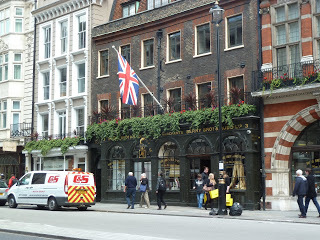 Berry Bros. and Rudd, wine merchants, est. 1698
Berry Bros. and Rudd, wine merchants, est. 1698
Their website is here.
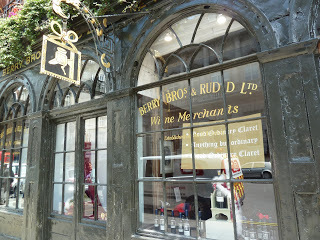
Through a narrow passage beside the shop is Pickering Place, a small courtyard reputed to be the sight of duels. They must have involved swords for certainly it is too small for gun play.
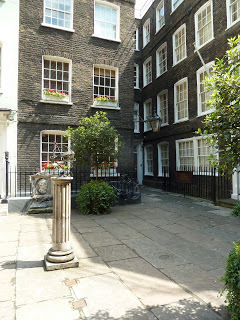
Nearby is Lock and Co. Hatters, est. 1676.
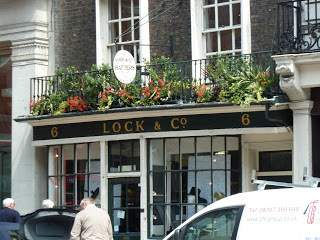
Their website is here.
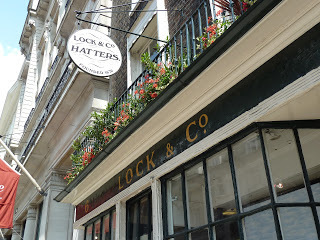
D. R. Harris, Chemists, is located at 29 St. James St. Their website is here.
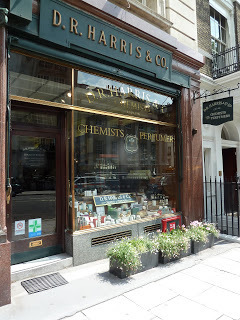
St. James Street is also the location of several of Britain's most prestigious gentleman's clubs. Below is Brook's.
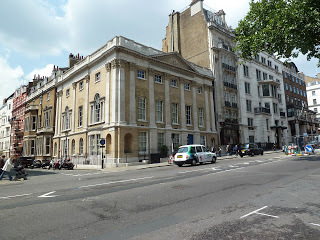
Here is the famous bow window of White's.
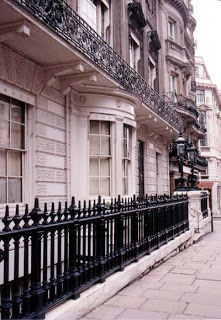
When I reached the top of St. James Street, at Piccadilly, I turned east once more and sought the comforting, yet stimulating, confines of Hatchards Bookshop. Oh, to be there once more!! Their website is here.
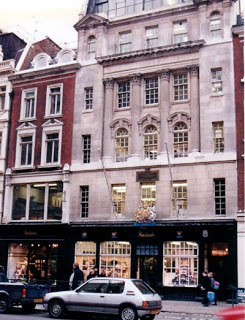
I will leave you here, as I immerse myself in some wonderful volume -- most likely more about London or British history.
[image error]

Since it was not only the day of Trooping the Colour but also part of the Open Squares weekend, the gardens of Marlborough House were open to the public. It is now the home of the Commonwealth Secretariat and Conference Center. The tents shown above not only dispensed hot tea, a necessity on this chilly day, but also displayed brochures and booklets on the 54 member nations of the Commonwealth. Anyone for a vacation in Tasmania?

Marlborough House was built for Sarah Churchill, first Duchess of Marlborough by Sir Christopher Wren, closely bordering the grounds of St. James Palace. Eventually the house was taken up by the crown and used by various members of the royal family. For many years, as the residence of Edward and Alexandra, it was the home of the Marlborough Set, a late Victorian social circle around the Prince of Wales.

My favorite feature of these gardens was most definitely the Pet Cemetery where Alexandra's dear little dogs are buried in a corner.

I walked to the opposite corner of the gardens and watched the troops escorting the Queen back to Buckingham Palace. I stood on a mound inside the wall that gave an excellent views, only partially blocked by the police and mounted officers along the route.

A memorial to Queen Alexandria is built into the garden wall of Marlborough House, just opposite St. James Palace.
 East facade of St. James, facing the grounds of Marlborough House
East facade of St. James, facing the grounds of Marlborough House Queen's Chapel, opposite St James Palace, north of Marlborough House
Queen's Chapel, opposite St James Palace, north of Marlborough HouseThe Queen's Chapel was built for Henrietta Maria, wife of Charles I, in 1625 and designed by Inigo Jones. It is used for services at various times of the year that are open to the public. It was originally Roman Catholic but is now Church of England.
I walked around the corner of St. James Palace to the more familiar facade of the palace which faces north, up St. James St. toward Piccadilly.

From here on, the royal connections are more limited: the warrants given to various merchants which supply the royal family and the memberships various royals hold in the gentleman's clubs.
 Berry Bros. and Rudd, wine merchants, est. 1698
Berry Bros. and Rudd, wine merchants, est. 1698Their website is here.

Through a narrow passage beside the shop is Pickering Place, a small courtyard reputed to be the sight of duels. They must have involved swords for certainly it is too small for gun play.

Nearby is Lock and Co. Hatters, est. 1676.

Their website is here.

D. R. Harris, Chemists, is located at 29 St. James St. Their website is here.

St. James Street is also the location of several of Britain's most prestigious gentleman's clubs. Below is Brook's.

Here is the famous bow window of White's.

When I reached the top of St. James Street, at Piccadilly, I turned east once more and sought the comforting, yet stimulating, confines of Hatchards Bookshop. Oh, to be there once more!! Their website is here.

I will leave you here, as I immerse myself in some wonderful volume -- most likely more about London or British history.
[image error]
Published on May 09, 2012 01:00
May 7, 2012
Thomas Crapper Is Alive And Well
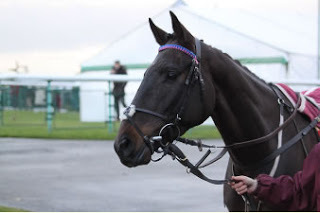
No, not the racehorse named Thomas Crapper, above. Though he's doing well, too - even has his own website and is owned by a syndicate that includes - you guessed it - Thomas Crapper and Co., which is the Crapper I was talking about. I recently discovered that they're still in business and offer a select range of bathroom fittings manufactured along the same Victorian and Edwardian designs first used by the firm.
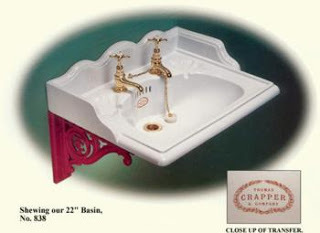
As everyone is aware, Thomas Crapper invented the W.C. as we know it today. According to the Company's website: "By the 1880's, Crapper and Co.'s reputation was such that they were invited to supply the Prince of Wales (later Edward VII) at Sandringham. Subsequently, Windsor Castle, Buckingham Palace and Westminster Abbey all benefited from Crapper goods and services. Crapper and Co. remained by Royal Appointment to Edward when he became king and was also warranted by George V, as Prince of Wales and once again as king.
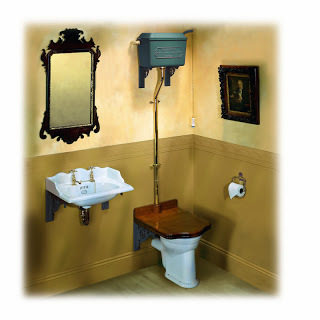
"Thomas Crapper died in 1910 and was buried near the grave of the cricketer, W.G. Grace, in Elmers End Cemetery. The company continued under the guidance of his old partner Robert M. Wharam, his son Robert G. Wharam and Mr. Crapper's nephew George Crapper. However by the late 1950s, after the demise of the original partners, it was evident to Robert G. Wharam that with no Crappers or Wharams left to run the business, the sale of the company was becoming inevitable. In addition, perhaps people cared little for quality and tradition during that period. In 1963 came the end of an era; Thomas Crapper and Co. became the property of a rival, Messrs. John Bolding and Sons, Ltd."
Today, the firm has been resurrected and, whislt the website doesn't tell us quite how this came about, do we really care? The fact remains that we can now purchase and use authentic period lavatory items designed by Crapper himself, including, but not limited to:
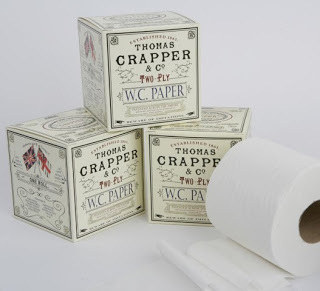 [image error]
[image error]
Published on May 07, 2012 00:04
May 5, 2012
A Day With JASNA-WI
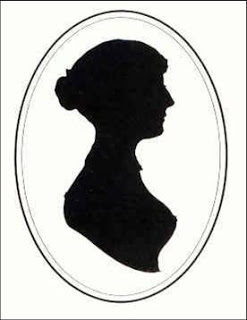
The Spring Gala of the Wisconsin Region of the Jane Austen Society of North America was held on April 28 at the Wisconsin Club, historic home of Alexander Mitchell (1817-1887), a Scottish-born business leader in Milwaukee. More about the Mitchell Family below.
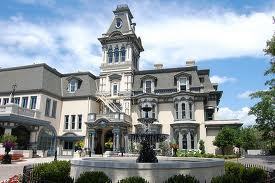
The program began with Sheryl Craig, a JASNA traveling scholar and editor of JASNA News. Dr. Craig presented her AGM talk on the economic background of Sense and Sensibility: "Wealth Has Much to Do With It.." Jane Austen was a keen observer of economic and social conditions in the year 1795 when she was writing the first draft of the novel, then known as Elinor and Marianne.
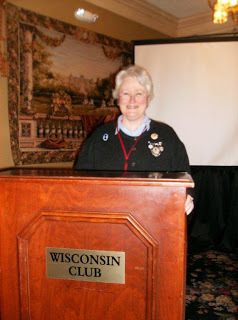
Dr. Craig illustrated her points by summarizing the character and attitude of the three "Johns" in Sense and Sensibility, who represented three common if differing positions among the English gentry of the period. The miserly Mr. John Dashwood leaves his step-mother and half-sisters nearly destitute as he tends to his so-called improvements of Norland Park, including the enclosure of common lands, thus depriving the poor and working class of their former rights. John Willoughby is a selfish, money-grubbing rake who ruins Eliza and breaks Marianne's heart while he seeks a wealthy wife.
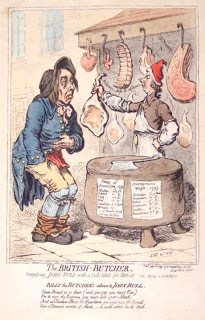 Gillray Cartoon showing P. M. Pitt offering a cut of beef to a man unable to afford a loaf of bread
Gillray Cartoon showing P. M. Pitt offering a cut of beef to a man unable to afford a loaf of breadSir John Middleton represents the honest landowners who care for their property, tenants and neighborhoods, generous and accommodating to friends, acquaintances and family alike. Dr. Craig's discussion of the parliamentary debates on reform of the Poor Laws in that period prompted many in the audience to draw parallels between the times of Prime Minister Pitt and today's news from London and Washington.
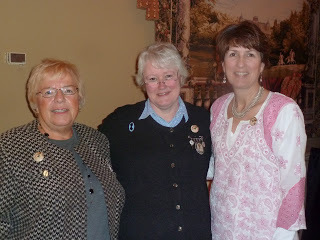 Presenters Victoria Hinshaw, Dr. Sheryl Craig, and JASNA-WI Regional Coordinator Elizabeth Cooper
Presenters Victoria Hinshaw, Dr. Sheryl Craig, and JASNA-WI Regional Coordinator Elizabeth Cooper"The Sensible Regency Wedding" was the topic of Victoria Hinshaw. She spoke about the modest and quiet nature of most regency weddings, including those of Jane Austen's niece as recounted by Caroline Austen and the quiet nuptials of Lord Byron and Annabella Millbanke as reported by John Cam Hobhouse.
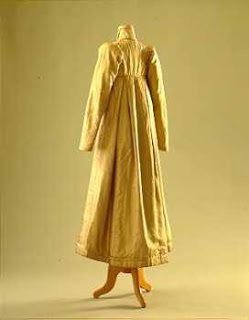 Lady Byron's Wedding Pelisse, Museum of Costume, Bath
Lady Byron's Wedding Pelisse, Museum of Costume, BathHinshaw also discussed courtship, the legalities of marriage, wedding customs, elopements, separation and divorce. She commented on Jane Austen's attitude toward love and marriage as expressed in her life, her letters and her novels.
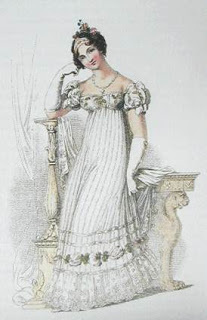 Wedding Gown, Ackermann's Repository, June 1816
Wedding Gown, Ackermann's Repository, June 1816JASNA-WI members and guests enjoyed socializing before and after the presentations. There is never enough time to talk about Jane Austen.
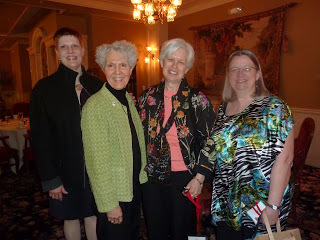
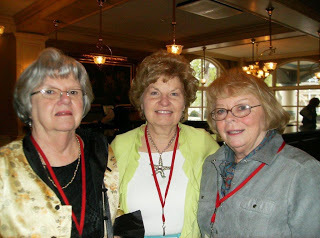
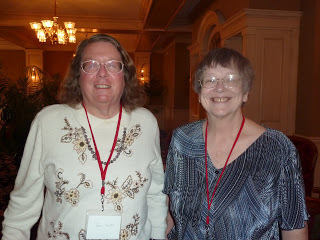
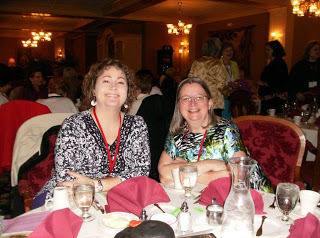
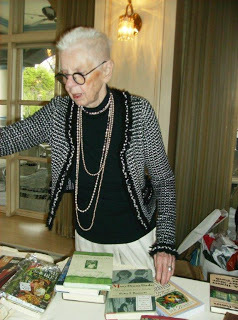 Pat Latkin brought us many temptations.
Pat Latkin brought us many temptations.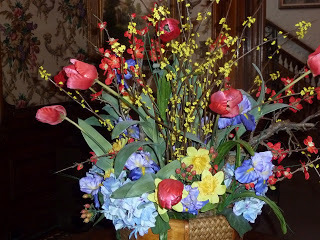 Spring Flowers in the foyer.
Spring Flowers in the foyer.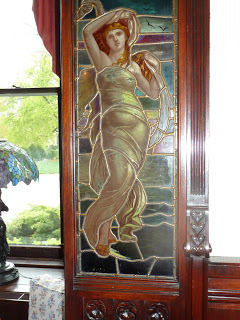 scene in The Wisconsin Club
scene in The Wisconsin ClubAlexander Mitchell (1817-1887) was born in Aberdeenshire, Scotland, and came to the U.S. in 1839. He settled in Milwaukee where he became a business leader in banking, insurance and railroads. He served in the U.S. Congress and was a local philanthropist. His wife, Martha Reid, was a leader in civic activities and artistic circles; she was one of the founders of The Woman's Club of Wisconsin in 1876. Their grandson, WWI flying ace General Billy Mitchell, is known as the Father of the U.S. Airforce.
Thanks to Judy Beine for her photographs.[image error]
Published on May 05, 2012 01:00
Kristine Hughes's Blog
- Kristine Hughes's profile
- 6 followers
Kristine Hughes isn't a Goodreads Author
(yet),
but they
do have a blog,
so here are some recent posts imported from
their feed.



